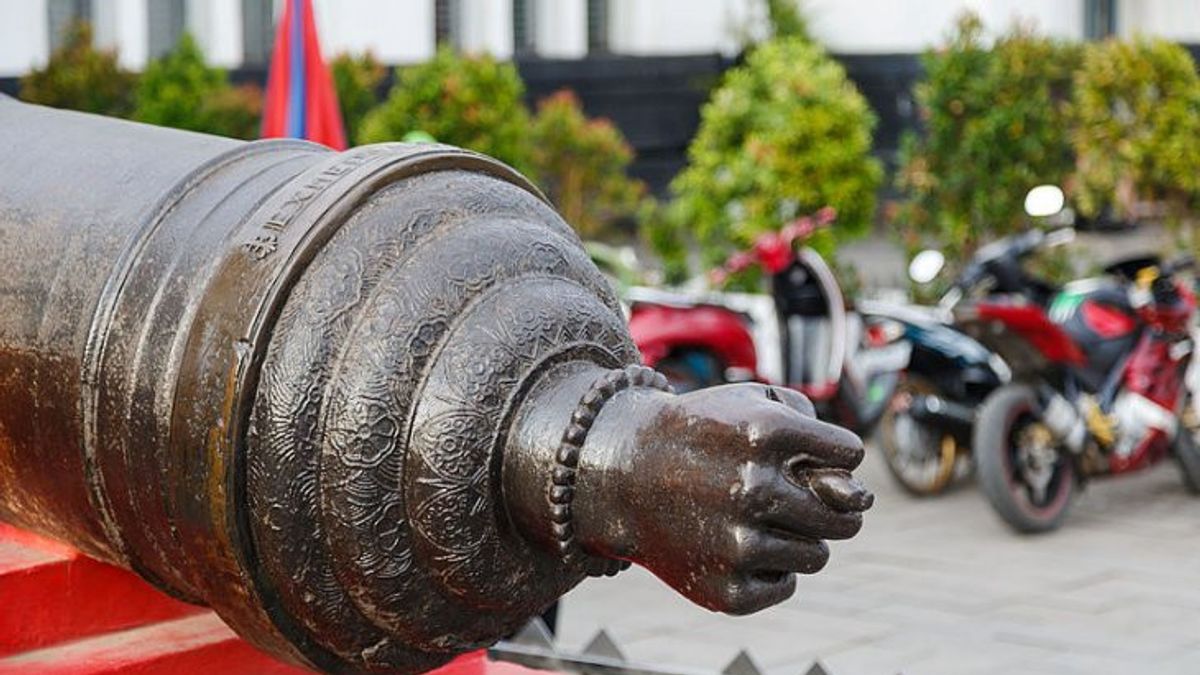JAKARTA - The charm of Si Jagur cannon is able to boost tourism in Jakarta. In fact, since time immemorial. The Jagur was once a formidable defense tool. However, when it's finished sweet, it's thrown away. The Dutch East Indies colonial government just abandoned it, since the center of government was moved. The abandonment actually bears sweet fruit. Si Jagur was greeted enthusiastically by the natives. The 'thumb pinched' cannon is considered sacred. Whoever wants to be rich to have children can be granted. This is the history.
The Jagur Cannon has a long history. He did not just come to enliven the historic objects owned by DKI Jakarta. Therefore, the memory VOI Team tried to follow his footsteps. Alias reviews the reason Si Jagur is sacred, then abandoned.
Wednesday, June 23, 2022, we arrived in the Old City from the morning. The goal is to obtain a permit for coverage around Kota Tua to the Kota Tua Area Management Unit. The owner of the area asked us where we were going. Spontaneously, we said that we wanted to review about the Si Jagur Cannon.
After getting permission, we went straight to the front page of the Jakarta History Museum (Museum Fatahillah). Where the Jagur Cannon is located. The visit was intentional. We want to know the views of contemporary visitors regarding the Si Jagur Cannon.

The average visitor we met did not know for sure the history of Si Jagur. But, that does not mean Si Jagur has no appeal. The Jagur clearly has charm. The pinched thumb symbol makes Si Jagur a photo spot that attracts visitors. After all, those who take pictures with cannons, which are considered to contain symbols of sexual intercourse, are often the subject of laughter or jokes.
"The cannon is unique, a bit pornographic, however," said Ani, one of the visitors.
Not only Ani, other visitors also had similar comments. We also found no sacred elements from the cannon. Si Jagur is treated like a historical object in general. Just seen, observed, and photographed.
Even then, Si Jagur is immortalized in the picture from a distance. Because, around Si Jagur has installed a fence that does not allow people to approach.
The Beginning of MakingThe story of Si Jagur's cannon begins with a famous Portuguese gunsmith, Manuel Tavares Baccarro. In his hands, 16 small cannons were melted down. The smelting resulted in a large cannon. It weighs 3.5 tons, is 3.85 meters long and has a barrel diameter of 25 centimeters. Cannon Si Jagur is his name.
The name Si Jagur is a simplification of the name of a Portuguese fort in Macau, Fort Santo Jago de Barra. In the Fort Si Jagur was placed. The presence of Si Jagur was predicted to be effective in repelling the Portuguese enemies. The greatness of Si Jagur made the Portuguese bring Si Jagur to Melaka. The cannon was placed in the Portuguese Fort in Melaka, A Famosa Fort.
However, that does not mean Si Jagur is invincible. The Dutch trading company, the VOC, was actually able to overturn the Portuguese domination in Malacca. The Portuguese troops were repulsed. As spoils, Cannon Si Jago was brought to Batavia in 1641.
The VOC placed Si Jagur to maintain security in Fort Batavia, which overlooks the sea. The goal is that enemy ships that come can be anticipated. Since then Si Jagur has completely become part of the VOC defense.

The existence of Si Jagur's cannon to maintain security lasted for quite a long time. Si Jagur's glory was only forced to end when the VOC era had been replaced by the Dutch East Indies Colonial Government. Governor General Herman Willem Daendels is behind it.
He moved the center of government from Oud Batavia (old Batavia), to Weltevreden (now: the area around Lapangan Banteng) in 1808. The move was carried out by destroying the fort and Kasteel Batavia. The Si Jagur cannon was left lying in the area near Kasteel Batavia or commonly known as the Kota Diamond area.
“The Jagur was brought to Batavia after the VOC captured Malacca (1641). Then the cannon that spewed 24 pound bullets was placed in Batavia Fort to guard the harbor. Apparently, this cannon was forgotten or left behind because it was too heavy, when the fortress of Batavia was demolished by Daendels (1809).”
“On this cannon it is written in Latin: EX me Ipsa renata sVm – from myself I was born again. This sentence shows, that Si Jagur is poured from 16 (=X+I+V) small cannons. This cannon was poured by MT Bocarro in Macau for the Portuguese Fort in Malacca,” the story of an important figure for the writing of the history of Jakarta, Adolf Heuken SJ in the book Historic Places in Jakarta (2016).
Considered Sacred CannonWe tried to visit the location of Si Jagur's cannon to Diamond City. The Si Jagur cannon was said to have been placed not far from the Kota Intan Bridge. There, we tried to understand why the Jagur Cannon was suddenly sacred.
In fact, it all started with a symbol that is considered pornographic: Thumbs Up. The symbol of sexual intercourse is known as mano in fica. Mano means hand, Fica means vulva. One of the oldest sexual symbols that allegedly came from Italy.
However, the understanding of the people of Batavia is not much different. Moreover, the influence of Hinduism is still strong. Hindu influences have accustomed people in Batavia to see symbols of sexual intercourse such as glancing at Linga (a symbol of virility) and Yoni (a symbol of fertility).
In conclusion, the symbol of mano in fica is considered a symbol of fertility. That is, the cannon of Si Jagur is considered sacred. People also believe that Si Jagur can grant any wish. From avoiding danger to having children.
“My guide Abdullah told me that many women believed that this ancient Portuguese cannon gave fertility so many native Indonesians, Chinese, and Indonesians who had no children came here and made offerings.”
"If the cannon is pleased, then the desire to have children will be achieved. At the back of the cannon there is a fist whose fingers and thumb positions remind the natives of the mystical symbol of the Hindu era: it symbolizes fertility," said HCC Clockener Brousson in his book Batavia Early 20th Century (2017).
Jagur's EndThe option of expecting blessings on Si Jagur is considered optimal. The Jagur narrative can "impregnate" many women everywhere. spread quickly. As a result, pilgrims who come expecting Si Jagur's blessings explode. They did not only come from Batavia alone. But also from Bandung, Cirebon, and Surabaya. This condition lasted until Indonesia became independent.
The DKI Jakarta government is also concerned about this condition. Maybe Si Jagur can be an attraction that brings people to Jakarta. However, its mystical and superstitious appeal goes against common sense. The government is also planning. The owner transferred Si Jagur to the National Museum in 1950.
The tactic worked for a while. Moreover, the position of Si Jagur was placed in the warehouse. But that doesn't mean museum visitors who hope for Si Jagur's blessings then disappear. They still come with their own offerings. This action often troubled museum officials. Because it's done in secret.
Gradually, those who came expecting Si Jagur's blessings increased. The DKI Jakarta government doesn't want to bother. They moved it back. The Wayang Museum became Si Jagur's new home in 1968.

Five years later, Si Jagur was moved again to the backyard of the Jakarta History Museum in 1974. The former location of the Si Jagur cannon can be seen to this day. The last time Si Jagur was moved back to the front page of the Jakarta History Museum in 2002.
The transfer made visitors no longer consider Si Jagur sacred. The Jagur began to be abandoned. Likewise with the stories of his magic. After all, the lord had fortified Si Jagur with a fence, as it appeared today.
"Because of that (often triggering shirk), the cannon was moved to the backyard of the former City Hall (Stad Huis) building in Fatahillah Park, West Jakarta, which was used as the Jakarta Museum. Now the cannon has reportedly been moved back to the front page and can be seen by the public,” concluded Betawi Culturalist Abdul Chaer in his book Folklore Betawi (2012).
The English, Chinese, Japanese, Arabic, and French versions are automatically generated by the AI. So there may still be inaccuracies in translating, please always see Indonesian as our main language. (system supported by DigitalSiber.id)









